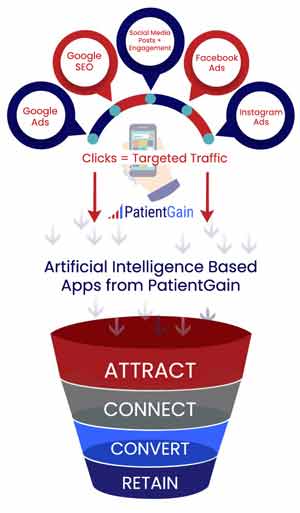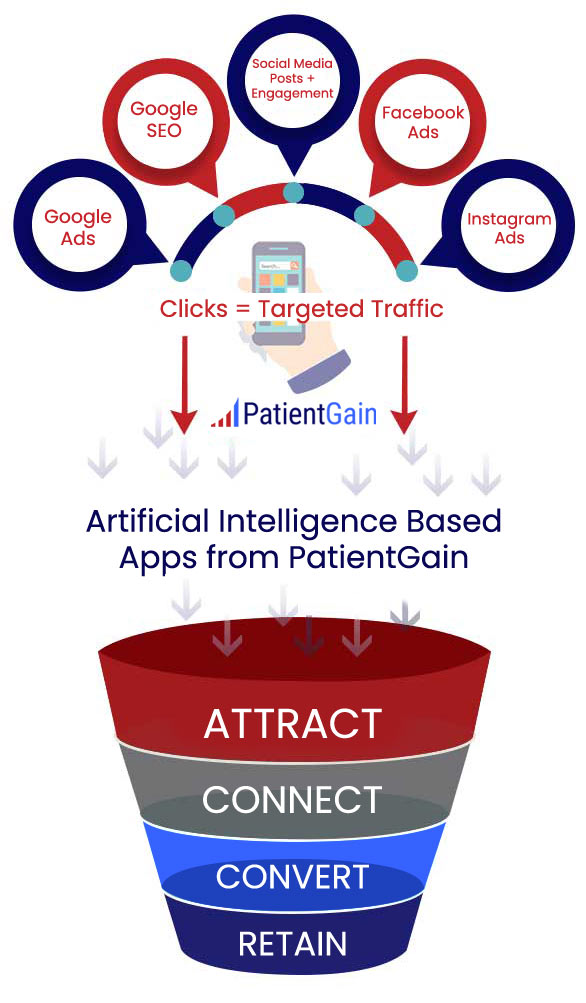Patient Engagement Strategies For Doctors and Dentists
7 ways to engage your patients using digital patient engagement platform. The more you engage your patients and potential patients, the higher the conversion rate you will get to get patients to come to your medical practice.
The more you engage your patients and potential patients, the higher the conversion rate you will get to get patients to come to your medical practice. Yes, you will undoubtedly attract some new patients passively by having an “open sign,” a website, and a directory listing. However, if you want to grow your business and patient count, engaging with them will help you push those numbers higher. Below are some ways for you to engage with your patients using a digital patient engagement platform. The expert team at PatientGain.com can help you utilize these methods to help your medical practice succeed!

Patient Engagement Strategies for Medical Practices
Effective patient engagement goes beyond simply providing information. It’s about creating a dynamic two-way communication channel, fostering trust, and empowering patients to actively participate in their healthcare journey. Here are distinctive strategies for engaging patients in medical practices:
Communication and Transparency
Multi-Channel Outreach
- Holistic Messaging: Use various platforms such as patient portals, emails, and text messages to deliver clear, concise, and consistent information about diagnoses, treatment options, and expected outcomes, ensuring patients receive information in their preferred manner.
- Interactive Communication: Encourage patients to engage actively by providing secure messaging options through patient portals, as well as phone and email communication, allowing them to ask questions and share concerns freely.
- Transparent Billing: Clearly explain treatment costs and insurance coverage upfront. Provide detailed breakdowns of charges and potential out-of-pocket expenses, minimizing confusion and enhancing trust.
Education and Empowerment
Tailored Educational Resources
- Customized Content: Offer educational materials tailored to individual patient needs, literacy levels, and learning styles, empowering patients to make informed decisions about their healthcare.
- Interactive Workshops: Host workshops and webinars to educate patients on managing chronic conditions, preventive care, and healthy lifestyle choices, encouraging self-management and proactive health behavior.
- Support Networks: Establish support groups and online communities where patients can share experiences, ask questions, and receive peer support, fostering a sense of belonging and empowerment.
Convenience and Accessibility
Seamless Online Access
- Online Scheduling: Implement a user-friendly online appointment booking system, allowing patients to schedule visits at their convenience without needing to call during business hours.
- Comprehensive Patient Portal: Provide a secure portal where patients can access their medical records, view test results, communicate with healthcare providers, and manage appointments, offering a centralized hub for their healthcare needs.
- Telehealth Integration: Expand access to care with telehealth consultations for appropriate conditions, making it easier for patients who have mobility issues or live in remote areas to receive medical attention.
Building Trust and Relationships
Empathetic Listening and Personalized Care
- Active Listening: Train staff to listen attentively to patients’ concerns and questions, demonstrating empathy and understanding to build stronger relationships and trust.
- Individualized Treatment Plans: Focus on patient-centered care by considering each patient’s unique needs, preferences, and values when making treatment decisions, ensuring they feel valued and respected.
Reputation Management
- Proactive Review Encouragement: Encourage satisfied patients to leave positive reviews on platforms like Google My Business and Healthgrades. Actively manage and respond to reviews, addressing feedback professionally and promptly.
Modern Digital Engagement Techniques
Automated Reminders
- Smart Notifications: Use automated systems to send personalized appointment reminders and follow-up messages via text or email, reducing no-shows and improving adherence to treatment plans.
Patient Feedback Apps
- Regular Surveys: Implement regular patient satisfaction surveys to gather valuable feedback, understand patient experiences, and identify areas for improvement.
Community Involvement
- Health Initiatives: Participate in local health fairs, offer educational workshops, and collaborate with community organizations to promote preventive care and build strong community ties.
Leveraging Technology for Engagement
Performance Monitoring and Analytics
- Data-Driven Insights: Utilize analytics to track key metrics such as appointment adherence, patient portal engagement, and survey responses. Use this data to refine engagement strategies and improve outcomes.
- Real-Time Adjustments: Adapt strategies in real-time based on performance data and patient feedback, ensuring ongoing relevance and effectiveness.
Advanced Communication Tools
- AI-Powered Chatbots: Integrate AI-driven chatbots on your website to provide instant responses to common queries, guide patients to the right resources, and enhance engagement.
- Wearable Integration: Encourage the use of wearable health devices that monitor vital signs and fitness levels. Integrate this data into patient records for continuous monitoring and proactive healthcare management.
Loyalty and Incentive Programs
Wellness Incentives
- Health Challenges: Organize wellness challenges and offer incentives for participation, promoting healthy behaviors and fostering a sense of community.
- Loyalty Programs: Develop programs that reward patients for regular check-ups, participating in health programs, or referring new patients, enhancing patient loyalty and engagement.
Comprehensive Patient Engagement Approach
- Personalized Follow-Ups
- Post-Visit Communications: Send personalized follow-up emails or calls to check on patients’ progress, remind them of any next steps, and reinforce their commitment to health.
- Interactive Social Media
- Engaging Content: Share interactive content such as live Q&A sessions, health tips, and patient success stories on social media platforms to foster engagement and build a loyal online community.
- Innovative Educational Tools
- Interactive Videos and Tutorials: Create engaging videos and interactive tutorials that explain medical procedures, preventive care tips, and general health advice, making complex information more accessible.
Below are some ways for you to engage with your patients using a digital patient engagement platform from PatientGain. Service is typically PLATINUM or GOLD. The expert team at PatientGain.com can help you utilize these methods to help your medical practice succeed!
1. Texting from the website – 2-way texting app.
Text messages are a powerful engagement tool that many medical practices do not use or embrace. The vast majority of your patients will have a mobile phone. If you check your website analytics, you will also see that many website visits to your site are from mobile devices. Nearly everyone who has a mobile phone has a texting plan allowing you to connect with them over SMS messaging.
You may not realize this, but you can connect with patients via text without having a dedicated phone at your clinic to receive texts. Instead of using a phone, install a two-way texting app onto your website. Patients, via their phone, can text your website with their inquiry or request for more information. Their message will arrive on your end and appear on your dashboard. From there, you can either call the person back on the phone for clarification or text them about the information they are looking for. Unlike email, text messages have a remarkably high open rate and there is no spam folder, so if you send a text back to someone, they will most likely read it. Patients’ ability to text a medical practice through their website opens a whole new avenue to connect with them.
A vital key to two way texting is to respond to new leads from website on a timely basis. The two-way texting app we have available at PatientGain.com is designed to capture leads using texting/SMS. Any messages sent to your medical practice through your website is kept on a secure server. You still must be mindful of what you send back to a patient. Their phone on their end is not a secured device, so you have to be careful not to send a PHI to them, like test results. However, this is a great way to transmit necessary information to them or to alert a patient to call your practice for more personalized information.
2. Medical marketing chatbots
Medical marketing chatbots are a great way to engage current and potential patients on your website. A chatbot is just a program designed to engage and mimic human conversation with someone on a website. A chatbot ability to help patients is dictated by the questions and answers programmed into it. Some people mistake a chatbot for an actual person or a futuristic AI program. While technology is not there quite yet, a well-designed chatbot can help patients in many different ways.
Many chatbots are designed to help patients get the information they need or accomplish simple tasks. Many medical practices ask their staff to list the most common questions they receive and then use them to program what questions a chatbot can answer when someone visits a medical practice’s website. The idea is that the more common questions a chatbot can answer and tasks it can help patients accomplish, the better. This frees up your staff from the phones to help patients with more complicated issues and helps prevent a patient from giving up on what they wanted to do on your website and moving on to a competitor. When a question or task is beyond a chatbot’s programming, many will take a message and organize it on a dashboard for staff to handle later.
3. Email marketing
While not as powerful as it once was, medical practices can still use email marketing to their advantage. When patients come to your clinic for medical care, they will give many personal details, and many will also include an email for communication. With this in mind, you will have many emails to work with to send promotional emails. Instead of using your work email to send out these messages, you should use an email marketing app. Why? First, you will track how many emails are opened and what links are clicked on. Second, by law, you must provide a way for people to unsubscribe if they did not wish to receive emails from you. While you could do this manually, at some point, you will have thousands and thousands of emails to work with, and an automatic unsubscription feature will be beneficial.
The key to effective email marketing is the design and messaging you use in your emails. Sending an email every day of the week saying you are open will skyrocket your unsubscribe rates and spam reports. Yes, big stores like Target or Wal-Mart send out emails every day, but they are multi-billion dollar businesses offering sales and discounts on different products every day. For a medical practice, aim to send an email out once every two weeks to a month. You could try for one every week, but you may find it challenging to produce that sort of content every week. When designing your email, you want it to be useful, engaging, relevant, and informative. Some of the most popular topics to talk about in an email campaign include:
• New hires
• New services
• Current health issues
• Upcoming events
4. Social Media
It is highly recommended that all medical practices engage with patients through social media channels. If you ignore this potential engagement route, you are ceding space to your competitors, where they can convert visitors into patients. The most common places to post on social media for medical practice are Facebook, Google, Instagram, and Twitter. Each social media channel is a little different in what you can and can not do.
On Facebook, you need to create a business page, not a profile. From a page, you can access insights, metrics, and their advertising platform. Facebook, of the four different social media channels, offers the most variety in the types of posts you can make, and there is no limit to the amount of content you can post. On Facebook, you can post:
• Text Posts: Good for quick updates, messages of low importance, or if you want to share a link to a story.
• Picture Posts: Like text posts, but includes a picture. These work best if you use an infographic or an authentic image from the clinic. It can get great engagement with your followers.
• Video Posts: Like picture posts, but instead, you use a video. These tend to generate even more engagement than a picture post. You can share a video from your clinic, or a video created to talk about a medical related topic.
• Event Post: You can create an event on Facebook to invite people to and allow them to invite their friends as well.
If you have a Google Business profile, you can post updates to your profile to display when your business knowledge panel is displayed. The content you can post on a Google Business profile is very similar to what you can post on a Facebook Page. You can post text, pictures, videos, as well as create events. There are a few more options on Google, but this is geared more towards retail businesses, and you may not have much use for them for your medical practice. A med spa may have some use for posts highlighting products.
Instagram, while owned by Facebook, functions a bit differently than Facebook. First, every post you make on Instagram must include a picture or a video. You can not only post text on your Instagram account, although some people will post pictures of text to amplify their message. Also, you can not embed links into Instagram posts. You can have a link in your bio, and if you advertise, you can embed a link into that promotion. A big thing to use with Instagram is hashtags. They allow you to categorize your post into different topics, and it is a great way to get exposure.
Posting on Twitter is similar to Facebook, but you are limited to 280 characters, including spaces and punctuation. Here, you can use text, pictures, and videos for up to 2 minutes to highlight your message. Hashtags are also popular on this social media platform, but every hashtag you use cuts into the number of characters available for your message.
5. Promotions app
A promotions app embedded into your website is a great way to increase your website’s overall conversions. Using branded promotions, patients can redeem them using a “Pay Now” function. PatientGain.com has a great promotions app that many clients use to bring in patients to their medical clinic. You do not need to do any coding or promotion creation. We will create branded promotions to use on your website that are also available on the mobile version of it
For a promotions app to be successful, you need to design a great promotion that highlights something people want. An irrelevant promotion is not useful to a patient will not get a lot of traction on your website. Once you create a great promotion, the real question is where to place it for people to find. You will want it presented on your website. However, you also want to spread the word about it by talking about a promo in your monthly newsletters to your patients. PaitentGain.com can also embed this promotions app into your Facebook Business Page, so it is just another tab your patients to visit and explore. Finally, you should post about your promotion across all of your social media channels: Facebook, Twitter, Instagram, and Google. Do not over post it, or it will be quickly ignored, but include it now and again in your social media posting schedule.
6. Assessment app
A medical assessment app is a great way to engage with patients on your website and help them figure out what they could be suffering from while exploring your website. Studies have shown that when these apps are used on medical websites, the conversation rate can increase by over 20%. They are a great way to help patients determine if they do need assistance from your providers and can motivate them to take the next step and confirm an appointment.
You want this assessment to be HIPAA compliant. It can only be visible to them and a doctor. A patient will often also need to sign up and agree to legal terms of use to access this app. This is a formality that many assessments apps have to protect the provider from offering it. Another key to this app is for a patient to submit contact information for follow up and further information from a medical clinic. PatientGain.com can help your medical practice design an assessment that fits best with the service you offer. Some of the most common types of medical practices that use online assessments include:
• MedSpas
• Medical Weight Loss Clinics
• Diabetic Treatment Centers
• Cardiac Treatment Centers
• Wellness Clinics
7. Quiz App
When a new website visitor explores your website, you do not have very long to engage with them or get their attention. If you fail to interest them or help them accomplish the reason why they came to this website in the first place, they will move on to a competitor in their search results. A 15-second quiz app will draw them in, have them linger on your website, and increase the chances for them to engage more with you.


PatientGain.com can help your practice using these engagement strategies to build your business. Make an appointment today and talk with our team about how we’ve employed these with other clients. We look forward to helping you grow your business!
